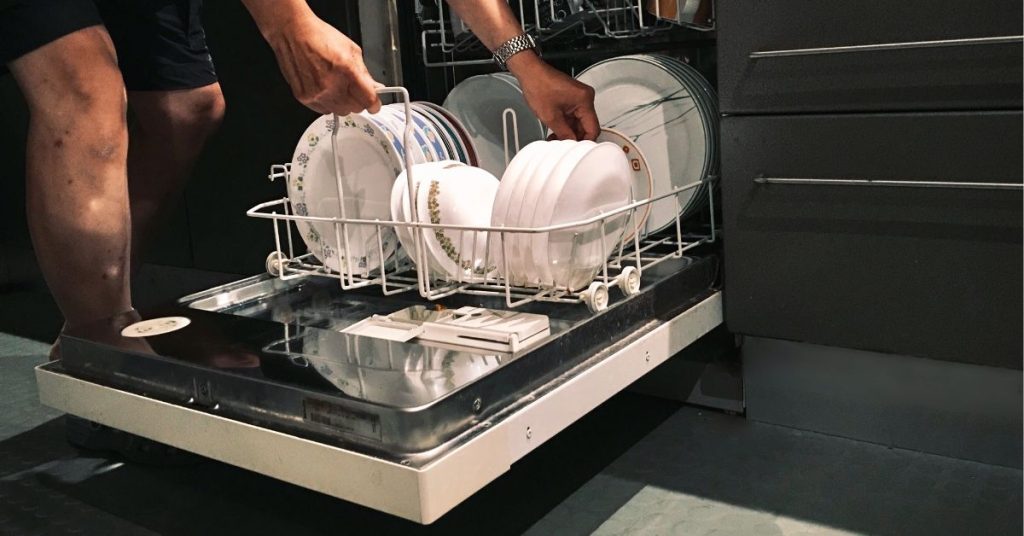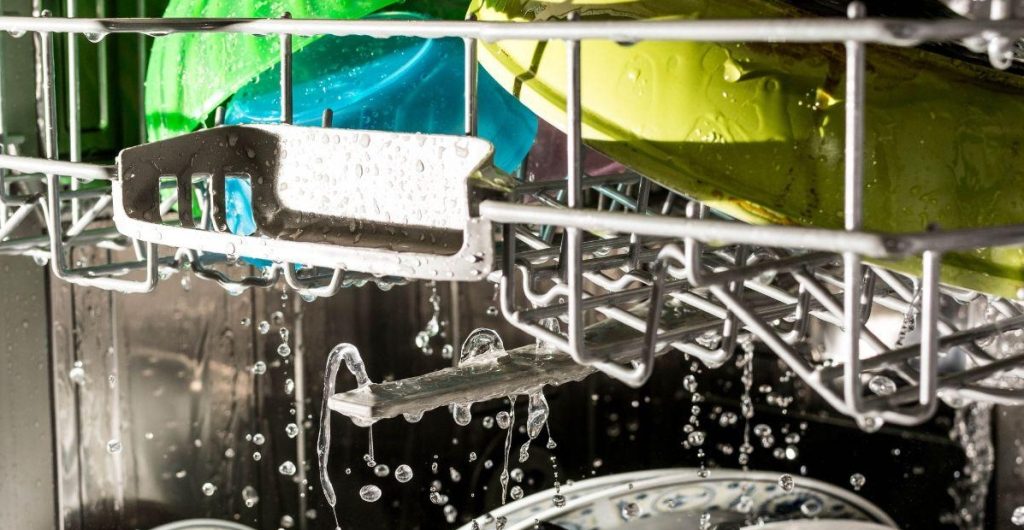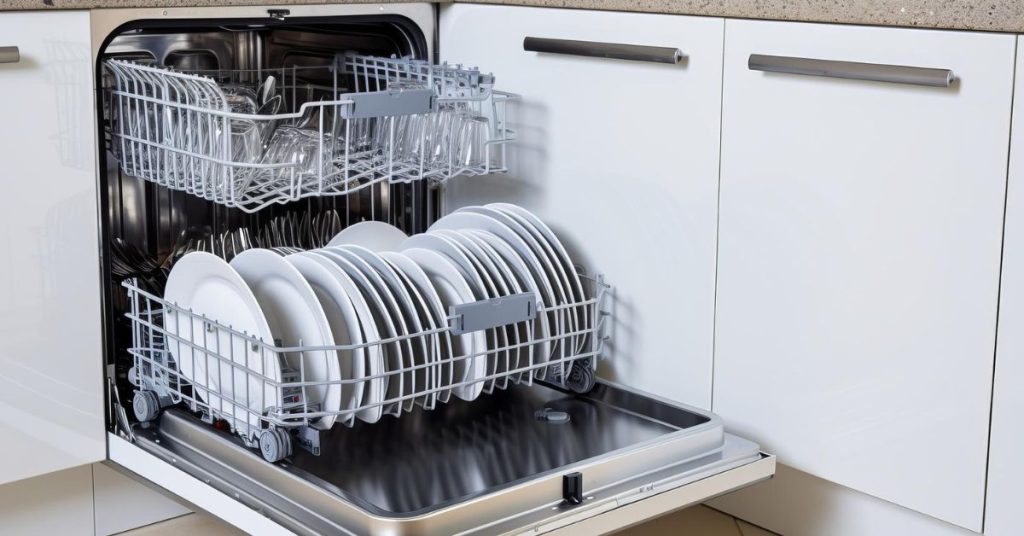There are a few dishwasher types that you might consider for your home, including freestanding and built-in dishwashers. The best option for you will depend on your lifestyle and household needs. Suppose you’re installing your dishwasher in a fitted kitchen. In that case, you might favour an integrated model to blend in with your units. A fully-integrated dishwasher has the controls at the top edge of the door, whilst the appliance front is completely concealed behind a fascia that matches your cupboards. A semi-integrated dishwasher has a control panel toward the top of the door, whilst the lower portion remains concealed behind a fascia that matches your cupboards. Freestanding dishwashers are self-contained with no need to install a fascia panel
Your choice to buy a built-in, portable, or countertop dishwasher will depend significantly on whether you are renting or own your home, the size of your home, and the size of your household. Each dishwasher model has its benefits and constraints. Drawer types are another built-in style to consider if you have little space or prefer the convenience of a drawer. When it comes to price, the most economical are countertop models. The countertop models are small (about 18 to 22 inches in width, height, and depth) and may not be sufficient for a large family, but if you are renting an apartment and have limited space, this may be the best option for you. It may be small, but a countertop dishwasher remains a time- and energy-saving solution for getting rid of those piles of dishes. Most models sit on the countertop next to the sink and are hooked up to the faucet.
Size and Capacity Considerations
The dishwasher size you choose will depend on how much space you have available. Suppose you have ample space for an integrated or freestanding dishwasher. In that case, you might like to choose a full-size appliance to get the most out of your area. Full-sized dishwashers are 60cm wide and an ideal choice for busy households with lots of dishes and pans to clean. If you’re working with a smaller kitchen, a slimline dishwasher won’t take up too much space that could be used for storage. Slimline dishwashers are 45cm wide and can be built-in for a seamless aesthetic. Alternatively, a compact dishwasher is a good option if you don’t have much space or many dishes to take care of. These are available in various sizes, usually similar in width to a standard dishwasher, but offering reduced height to fit into smaller spaces. [Source: Bosch UK – Dishwasher Buying Guide]
Dishwasher capacity is typically measured in terms of the number of place settings that will comfortably fit inside the unit. A place setting includes a dinner plate, side plate, soup bowl, glass, teacup and five pieces of cutlery. A standard 24-inch built-in dishwasher can usually hold up to 12 place settings, with some taller tub models holding up to 16. When choosing your next dishwasher, open each model and look at the tines. A dishwasher with less space between each tine means you will have more space to load dishes. Wider tines take up more space and don’t allow for large loads. [Source: The Home Depot – Dishwasher Buying Guide]
Key Features to Look For
Dishwashers now offer more than ever before! Thanks to smart technology and advanced features, that makes washing up less of a chore. Put control in the palm of your hand thanks to smart connectivity via Wi-Fi, Bluetooth and/or NFC which can give you: Dishwasher adjustable baskets allow for customizable loading options so you can easily fit the items you need washing: … Enjoy faster and more time-efficient washing. ➧ Perfect for when you’re in a rush or have only a few items to wash · ➧ Uses less water and energy, which can lower costs on your utility bills · ➧ Quick Wash cycles can range from 1 hour down to as little as just 15 minutes. [Source: Appliances Direct – Dishwasher Buying Guide]
The best dishwasher features for you will depend on your needs and preferences, but a few things are desirable for just about anyone. A stainless steel interior tub is better than plastic because it’s more durable and stainproof. And some level of adjustability in a dishwasher’s racks ensures that your dishes will fit. Not every dishwasher has every feature, but you can find a machine with the features that matter most to you. Some features cost more than others, though. A stainless steel interior tub is more durable than plastic and stains less easily, meaning it will last longer. You might like the look better, too. But it will add to the price. Some models, especially at higher prices, offer flexibility in their upper racks. You can adjust their height to accommodate taller dishware. Most dishwashers now have soil sensors, which detect how dirty your dishes are to determine how much water and time are needed to get them clean.
Energy Efficiency and Cost Savings
There are two main reasons why you should care about efficient energy levels: your household budget and the environment. The energy ratings go from A+++ to D, with A+++ being the most efficient. Larger dishwashers with A+++ ratings tend to be the most efficient. You can achieve the lowest energy and water consumption by making sure the dishwasher is full for each wash cycle. [Source: Mark’s Electrical – Dishwasher Buying Guide] Thanks to advanced technology, energy-efficient dishwashers use less water and electricity, and you will still get sparkling results. When you use less water, you can enjoy reduced household costs every month. Check out the EU energy label on our dishwashers to see which machines are not only better for the environment but will help you save money on your regular bills. Innovations like Bosch’s LoadSensor detect when you’re washing a smaller load to ensure only the necessary amount of water and electricity is used.
Noise Levels and Performance
Nobody wants the dinnertime conversation disrupted by the noisy rattle of a dishwasher. So, if you have an open-plan kitchen or want to put a programme on at night, look for a model with the quiet mark. This means they’re less noisy than standard dishwashers, so you’ll get to enjoy your evening in peace. [Source: AO.com – Dishwashers Buying Guide] Noise levels for dishwashers are indicated by their decibel level. A rating of 45 decibels or lower is a virtually silent dishwasher.
Your dishwasher should wash and dry dishes really well—that’s a given. Powerful cleaning: A good dishwasher should thoroughly clean your dishes and leave them decently dry. A lot of dishwashers have a hard time getting things fully dry—especially plastic items, which are tougher to dry than glass or ceramic—but your appliance shouldn’t leave them dripping wet. Quiet operation: The quietest dishwashers we recommend keep the noise level to a minimum. You won’t find a totally silent dishwasher, but the ones that score the best for noise in our tests keep the clanging and whooshing to a minimum.
Budget and Installation Considerations
The average cost for a new built-in or portable dishwasher is from $400 and $700. A top-end built-in dishwasher with all the bells and whistles can go up to $2,000. The average cost to install it is $150 to $200. Countertop dishwashers are some of the least expensive options, ranging from $250 to $650. It might be easiest to make a checklist of your must-haves with a new dishwasher. Take note of which things are deal-breakers. Some people have little tolerance for loud dishwashers. Other common concerns are water and energy consumption. Read the fine print on the model you like before you buy. [Source: The Spruce – How to Choose the Best Dishwasher]
It can take a professional about one hour to install a dishwasher if they do not have to make any significant kitchen modifications. Doing it yourself with no prior experience will likely take two to three hours to do the same job. Once you know the dimensions and are ready to purchase your appliance, select our installation service at the checkout to make the process even easier for you. [Source: Mark’s Electrical – Dishwasher Buying Guide]
Additional Tips and Considerations
From budget to personal style, several factors go into buying a dishwasher, so it’s important to think about what you need. How often do you cook at home? How frequently will you need to run your dishwasher? How large of a capacity will you need? Do you want the quietest dishwasher available? Are you looking for an energy-efficient model? By answering all these questions, you can narrow down the choices. You will also need the correct type of outlet for your new dishwasher installation: 3-prong plugs are used for homes built before the year 2000. [Source: The Home Depot – Dishwasher Buying Guide]
When you’ve chosen and installed the best dishwasher for your home, it’ll be essential to take care of your new appliance. How long your dishwasher lasts will depend on how well you take care of it. On average, these appliances work for between 6 and 16 years. Your dishwasher’s lifespan will also depend on the quality of the machine you choose, so it’s worth doing some research into the best options out there.
Frequently Asked Questions (FAQ)
Q: How much water does a dishwasher use compared to handwashing?
A: Dishwashers don’t use much water when compared to handwashing. A dishwasher will use around 11 litres of water per wash cycle. Whereas, hand washing will generally use about 60l. You can save up to 18,000l of water per year with a dishwasher!
Q: What is the average lifespan of a dishwasher?
A: A dishwasher should last around 10 years. Whichever fit you choose, your new dishwasher will need to be installed near a water supply and drainage point.
Q: Are dishwashers energy-efficient?
A: While it might seem counterintuitive, using your dishwasher is significantly more energy-efficient than washing by hand. That’s because most of the energy used in washing up is for heating the wash water, and dishwashers use significantly less water. The dishwashers in our tests use on average just a smidgeon over one kwh per cycle, so if you’re running your dishwasher once a week, it’ll only add $21.32 to your annual electricity bill.
Q: What’s the difference between stainless steel and plastic tubs?
A: Dishwasher tubs are either stainless steel or plastic. Stainless steel tubs resist stains and odors, dry out faster and are more durable. However, they are also more expensive. Plastic tubs are just as durable but are not as stain-resistant. The exterior finish does not indicate whether the tub is stainless steel or plastic. However, the tub material does not affect cleaning performance.
Q: How noisy is a typical dishwasher?
A: You can easily look up any dishwasher’s sound rating. Old fashioned dishwashers tended to rate around 80 dBs, meaning they were as loud as a disposal. Even $500 dishwashers now tend to have sound ratings in the mid-50s. 50 dB is about the noise level of a quiet conversation.
Q: Should I get a dishwasher with a child lock?
A: Child locks are an additional safety feature that you’ll find on many models. A dishwasher has extremely hot water, depending on the cycle, plus access to sharp objects like knives. It’s advisable to get a dishwasher with a child lock if you have young children.







